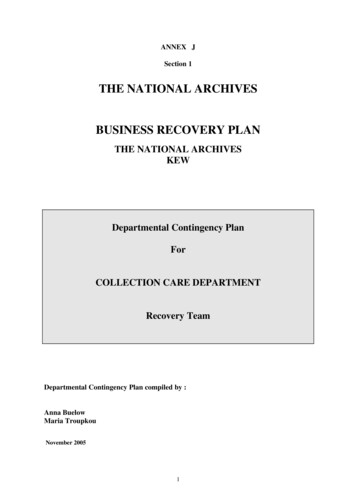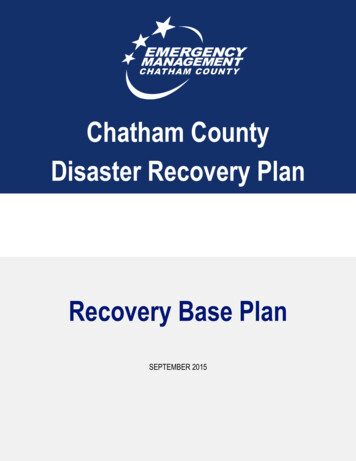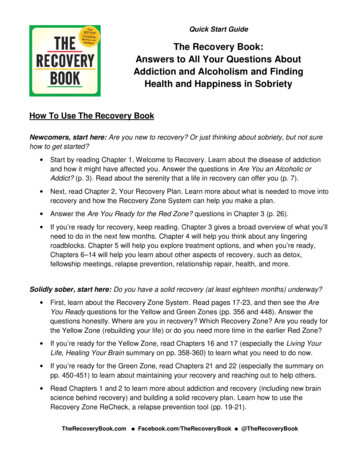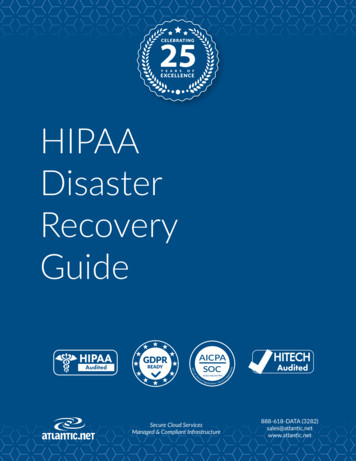
Transcription
ANNEX JSection 1THE NATIONAL ARCHIVESBUSINESS RECOVERY PLANTHE NATIONAL ARCHIVESKEWDepartmental Contingency PlanForCOLLECTION CARE DEPARTMENTRecovery TeamDepartmental Contingency Plan compiled by :Anna BuelowMaria TroupkouNovember 20051
CONTINGENCY PLAN FOR :COLLECTION CARE DEPARTMENTCONTENTS.1.DEPARTMENTAL CONTINGENCY PLAN1.1.OVERVIEW.1.2.1.2.1.1.2.2.CONTINGENCY PLAN ACTIVATION.Recovery Team.Recovery Site.1.3.1.3.1.1.3.2.CALL OUT PROCEDURES.Transportation Arrangements.Incident Control OVERY ACTIVITIES.Special Recovery Activities.Activity Checklist.I.T. / B.T. Applications.External and Internal Business Contacts.Agency Notification List.Vital Records.1.5.ESSENTIAL SERVICE SUPPLIERS.2.2.1.RECOVERY SITE REQUIREMENTS.Initial Recovery.Minimum Requirements.2.1.1.2.2.2.2.1.2.2.2.SUSTAINED RECOVERY.Normal Operational Requirements.Sustained Recovery Team.ANNEX.A.SPECIAL PROCEDURES.B.ESSENTIAL SERVICE SUPPLIERS.2
1. DEPARTMENTAL CONTINGENCY PLAN1.1. OVERVIEW.In the event of a disaster affecting the daily business operations of The National Archives, theBusiness Recovery Plan will be activated along with Departmental Contingency Plans for thosedepartments which are affected by the disaster.Departmental Contingency Plans should cater for the worst case scenario, and should containall information which would be required for the speedy return to normal operations. The planshould be treated as a flexible document, which should be tailored to suit the needs of yourdepartment within the framework outlined. If areas of the plan are not applicable to yourdepartment, disregard. If others require expanding, expand.The Departmental Contingency Plan will require periodic updating.1.2 CONTINGENCY PLAN ACTIVATIONActivation of The National Archives Business Recovery Plan will be a Management decision and noDepartmental Contingency Plan will be initiated until the Business Recovery Team (BRP) issues aninstruction to this effect. The Business Recovery Team will then alert the leaders of the DepartmentalRecovery Teams (DRT).After being contacted by Security, the first action of the Departmental Team Leader is to contact themembers of the Recovery Team. If the Team Leader is not available, the Deputy Team Leader willassume responsibility.1.2.1. Departmental Recovery Team.The following members of the department will form the Departmental Recovery Team. The TeamLeader and Deputy(ies) are identified against serial numbers 1 to 3.DRT’s primary task is to assess the situation and extent of the disaster affecting the department, callforward additional staff and resources as required, and undertake the initial steps in the recoveryprocess.The aim of the DRT is damage limitation, to manage the recovery process and the recovery to normaloperations.SerialNumber1.2.3.HomeTel NoName4.5.6.7.8.9.10.11.4FirstAider
12.13.14.15.We are on the Emergency Register for Harwell Drying and Restoration Services (www.harwelldrying.demon.co.uk, Head Office: Bldg 404.13, Harwell, Didcot, Oxfordshire, OX11 0RA, Tel.01235 432245, Fax 01235 432246, info@harwell-drying.co.uk). Even if the office is unsure as towhether their services will be required or not, they have expressed a preference to be notified and puton standby in case they are required.HARWELL01235 434373 (24-hours)1.2.2. Recovery Site.Your department will be advised as to the location of an alternative recovery site by the BusinessRecovery Team, as and when your Contingency Plan is activated. The requirements for an alternativerecovery location will depend on the nature of the disaster and on your departmental operations.1.3 CALL-OUT PROCEDURESDuring out of office hours. Security will contact members of the Departmental Recovery Team(DRT) as soon as possible after the instruction is issued from the Business Recovery Team (BRT).If the emergency occurs during business hours, all members of the department are to be assembled,a roll-call taken, and then depending on the nature of the emergency, those staff not required to dealwith the emergency told to go home and wait until contacted.1.3.1. Transportation Arrangements.Each member of the recovery team will be instructed to report to the Incident Control Centre (ICC),at The National Archives, the location of which will be advised.Transportation will be by public or personal transport, or in extreme circumstances by taxi which canonly be authorised by the Business Recovery Team.Any expenses incurred are to be recorded by the individual concerned, and passed to his / her linemanager for approval.1.3.2 Incident Control Centre (ICC)Within working hours an area within either Q1 or Q2 will be designated as the Incident ControlCentre for the management of the recovery process. Information concerning the location of the areaand any other information required will be given out over the PA system. If this facility is notfunctioning, recovery team members will be provided information either by telephone, security staffor by line managers.5
For a disaster occurring out of normal working hours, Recovery Team members should initiallyreport to the main entrance security desk, from where they will be directed to the ICC.In the event of a major disaster which restricts access into any parts of the building, the initialassembly location is to be the public car park at the Ruskin Avenue end.1.4. RECOVERY ACTIVITIES.Following the activation of the Departmental Contingency Plan the Departmental Recovery Team(DRT) will carry out pre-defined activities to recover business functions. A prioritized list ofrecovery activities is contained in section 1.4.1.The first responsibility of the Recovery Team Leader will be to ascertain the extent of the disaster,and to decide if the recovery can be managed by the Recovery Team or that the departmentalrecovery process will require additional members of their own or other department to assist.If this is the case then he is to request the assistance of the Business Recovery Team to contact eitherall or individual members of the department listed in Sustained Recovery Team (via Personnelrecords, see section 2.2.2.), or additional TNA staff from other areas of the business.1.4.1. Special Recovery Activities.An emergency which occurs either within or outside of business hours may present special recoveryactivities to be performed by the Departmental Recovery Team, prior to the start of theirdepartmental recovery process. These activities are listed below.No activities concerning either readers or visitors who may be present at the time of the emergencyare to be considered, other than their safe evacuation from the building. Arrangements for theirbelongings and safe removal from site will be managed by the Business Recovery Team andSecurity.ActivitySer NoDay / NightSpecial Recovery Activity1. The prime concern of the Collection Care Department, in a disaster situation, is to takewhat measures are necessary to salvage or limit the damage to as many of the recordsas possible.2. Initially it will be the responsibility of the first senior member of the departmentalrecovery team on site to start the recovery process after an initial assessment has beenmade.3. Secondary will be the recovery process of getting the department back to normaloperational levels.1.4.2Recovery Team Activity ChecklistThe activity checklist should include in order of priority, the actions and tasks which are required tobe carried out by the Department Recovery Team.Tasks listed should be identified as team tasks, or tasks designated to individual members of therecovery team who have specific skills required for the task.As each task is completed, it should be identified as such, so that an update of the recovery processcan be provided as required by the Business Recovery Team.6
TaskSer NoActivity / Task1. Ideally, the recovery process should start with a preliminary assessment of those documentsin the affected area, designated as being the most valuable or important, identified by thefirst senior member of staff to come on site.2. The method and process for assessing and treating damaged material is documented inAnnex A.3. Depending on the extent of the disaster it is possible that, in addition to many or all of theCollection Care staff being engaged in the document salvage process, staff from ArchiveProductions Services may be required. These will be contacted through the Head of ArchiveProduction Services, or Estates and Security Department.4. If the Collection Care Department has been affected by the disaster, it will be theresponsibility of the Collection Care Administrative Officer to start the process of bringingthe department back to normal operational levels. E.g. making sure computers andessential equipment are working and sufficient disaster material is available, particularlythose that may be required for the disaster recovery. For a full list of materials andequipment suppliers see Annex B.1.4.3. I.T. / B.T. Applications.Itemise any I.T. or B.T. equipment which is essential to the departmental recovery process, this toinclude telephones, PCs, printers and software applications:Equipment / Software.ComputerPrinterComputerPrinter *Qty.1122CriticalCategoryAABBApplication.Word; Excel; AccessWord; Excel; Access* Printer can be networked.The Critical Category symbols and their meaning :ABCDEssential, must be recovered soonest.24 hours.72 hours.When Convenient. Need access to PRONTO system information. Information on Collection Care’s ‘i’ drive: Collection Care databases Collection Care suppliers’ list Other networked databases (need to confirm that these have been added to network): Collection Care Finance database Safe Room Survey database Safe Room Locations database7
Unfit databaseNote.The category selected will depend on how essential an item of equipment is, to the recovery process. Forexample, Estates and Security Department would require access to telephone services at the earliestopportunity for contacts with suppliers, therefore Category A is appropriate - however a PC would not be asessential, therefore Category C would be more appropriate.1.4.4 Internal/External ContactsIdentify any business contacts or functions, internal or external, which are important / integral to thedepartmental operations:InternalContact & Function.Contact Name & Tel No.Archival Production Services Department for assistance with document salvage linked with their Departmental Contingency Plan.ExternalContact & Function.HARWELL Drying Restoration Services1.4.5Contact Name & Tel No.01235 434373Agency Notification ListAll contact with the Emergency Services, Government Departments and other Statutory Authoritiesare only to be made by the Business Recovery Team (BRT).In addition, notification and information concerning the disaster situation will be made by theBusiness Recovery Team (BRT). Other organisations or agencies which departments have dailybusiness contact with, either with contracted staff, goods or services are to be listed below.OrganisationContactTel NoRemarksNADFAS Volunteers will need to be informed, to ensure that they do not come to the site.At the first instance, notify:Greater London AreaVolunteersRepresentativeOr any other person atthis telephone numberNADFASThe last contact name is for general courtesy/information as she is the liaison for the whole GreaterLondon area.EDITORS WORKING ON CENSUS MATERIAL - HO CLASSThe editors need to be contacted to prevent them coming into The National Archives (especially asthey are undertaking work in the Collection Care Department’s Disaster Control Room).8
Manchester and Lancashire FHS contacts1.4.6Vital RecordsDetails of all departmental back-up files stored for safe keeping in off site locations, should be easilyretrievable during an emergency situation.The vital records comprise of : Paper / PC Disc / File / Archive Box / Other.Description :N/AThe departmental Vital Records are stored at :Address :N/AContact Name :Tel No :Access.The procedure for the retrieval of departmental Vital Records is on the authority of :Name :N/A1.5. ESSENTIAL SERVICE SUPPLIERS.Details of essential suppliers / agencies who currently support the department with essential servicesor supplies, are listed under Conservation/Preservation Materials and Suppliers in ANNEX B.The companies listed below may need to be informed of the emergency, and contacted in order tosuspend their activities or actively support the emergency.CompanyContract TitleTel. Number9
2. RECOVERY SITE REQUIREMENTS.2.1. Initial Recovery.Immediately following the activation of The National Archives Business Recovery Plan whichinvolves this department, it may be necessary to relocate the departmental operations to a RecoverySite. The resources of the site will be limited and the department may need to exist for a period oftime with limited resources.2.1.1. Minimum Requirements.The following minimum items of equipment are required to enable the initial recovery of thedepartment at a recovery site.Identify most critical I.T. and other office equipment to include basic furniture requirements. Bothphotocopy and telephones will be organised centrally.Equipment / TypeTables/worksurfacesChairsBoard chopperSinksFansDe-humidifiersApplicationsQtyAs much table space as possible to ensure that each 32 minimum (1eachConservator has a work bench for emergency conservation formember of thework plus additional surfaces for air drying or large workdepartment)32Cutting of materials1Access to a water supply - if not possible to have sinks, thenpipe-work / rubber hosing to connect to portable sink unitsFor air drying material10For lowering RH to aid air drying52.2. SUSTAINED RECOVERYDepending on the disaster situation, the department may be required to operate from the recovery sitefor a long period of time. In this situation additional equipment may be required to enable thedepartment to return to normal operations.2.2.1. Normal Operational Requirements.The following list identifies the equipment required for the department to return to normal operation.Equip / TypeSize orCapacityModel /ManufacturerI.T.ApplicationQtyList of essential conservation/preservation equipment and materials (see Annex B)2.2.2. Sustained Recovery Team.The following departmental personnel are not required as part of the Initial Recovery Team, but willbe additionally required by the department, in the sustained recovery mode.Ser NoNameHome Tel. No.Other Collection Care staff may be contacted via Personnel records.10
DEPARTMENTAL CONTINGENCY PLAN.FOR : COLLECTION CAREANNEX A.SPECIAL PROCEDURES.Each department may have special procedures which are required for the recovery of their business.These are to be listed, and should include for all special requirements for each individual function.Ser No.FunctionProcedure / Action / EquipmentSEE BELOW11
Small Incident Reaction ProcedureALL STAFF MUST WEAR PROTECTIVE CLOTHINGBEFORE STARTING WORKAIR DRYINGThis is appropriate for small quantities and/or slightly damaged material only, andshould be carried out under the supervision of the Collection Care Department. Thearea for air-drying should be large, well ventilated and well stocked with tables anddrying lines. The Collection Care Department on the Ground floor of Q2 is the firstchoice. (N.B. Make sure that the air conditioning is switched on if the incidentoccurs at the weekend, to give air-flow). If no area is available on site, material willneed to be packed and transported to a designated area. Use fans and de-humidifiers to assist the drying process, available fromCollection Care and Estates and Security Department. Stand damp volumes upright and gently fan out their pages. If possible,interleave with blotting paper. Books printed on coated paper and photographic prints should be interlaced withSilicone release paper to prevent blocking. That is available from Collection CareDepartment. Loose paper sheets should be placed between blotting paper or hung over adrying line. Parchment membranes should be placed between blotting paper under lightweights. Pendant seals should be supported. Change blotting papers regularly. Do not attempt to separate material that is stuck together, this is a job forCollection Care staff.12
Instructions for Disaster Control Volunteers on being contacted in theEvent of a Disaster1. In addition to being notified that a disaster has occurred, you will also be toldwhere to report. This will be known as the “Incident Control Centre”.2. Get to the Office as quickly as possible. Staff should use Public Transportwherever possible, however in exceptional circumstances a taxi can be authorisedby the Head of Department.3. When sufficient staff have arrived, a briefing will be given by the Recovery Teamor designated other.ALL STAFF MUST WEAR PROTECTIVE CLOTHINGBEFORE STARTING WORK.A Disaster Box containing protective clothing is located in Loading Bay 1, Q1ground floor. Protective clothing is also available from the Collection Care DisasterRoom, Q2, (Key ). The contents of these boxes are organized in the attachedDisaster Control List C.All disaster control staff must ensure that they are provided with the necessaryprotective clothing as soon as they arrive on site. The first person to arrive will beresponsible for issuing protective equipment.4. Make sure you receive the following information: The nature and location of disaster Which team you have been assigned to Assessment Area Rest Area(s) Location of First Aid area Information on any areas declared out of bounds13
Preservation Emergency SuppliesALL STAFF MUST WEAR PROTECTIVE CLOTHINGBEFORE STARTING WORKRed Disaster Boxes are stored in each repository and in the library:Q1 opposite every entrance to the repository areas on each floor (centre of thebuilding, in the Basement and floors 2, 3 and 4, Q1). in the far end of the Library, Q1 first floor . protective clothing is located in loading bay 1, Q1 Ground floor.Q2 in the Collection Care Department on the Ground floor, Q2. Collection Care Disaster Room, Q2 Ground floor (Key ). near their side entrance in each of the repositories 6c, 7c, and 8c (on the first,second and third floor, Q2).The contents of these sealed boxes (apart from the one in Loading Bay 1) areorganised in Disaster Control List B.Both Lists C and B are wall-mounted over the disaster boxes and should beupdated during annual inspections of the box contents by Archival ProductionServices (APS) staff.During monthly inspections, APS floor managers should also update theadditional Disaster Control List A, confirming that the boxes remain sealed whennot in use, and also that there is an adequate number of stacked collapsible cratesand foldable disaster tables on site.Detailed floor plans indicating the locations of all disaster boxes and additionalequipment, should be mounted on notice-boards above each box, alongside allthree content lists.Lists A, B and C are attached below.14
List A – All Disaster BoxesDISASTER CONTROLLIST A - WALL MOUNTEDSITE EQUIPMENT CHECKLIST (MONTHLY INSPECTIONS)LOCATION #INSPECTION DATEYEAR1x Red Disaster Box (securely tied with 1 to 3 Folding Assessment Tables (quantity 1 to 4 stacks of 12x Foldablestring, content list attached on the outside) in place, tabletop condition, easy unfolding) Crates (quantity in place, locationsmarked on floorplan)NAME(S)NOTES (Fault found - Date amended)123456789101112List B – All boxes (apart from Loading bay 1)DISASTER CONTROLLIST B - ATTACHED ON BOXBOX CONTENT CHECKLIST (ANNUAL INSPECTIONS)LOCATION #LOOSE IN BOXFoldable crates (open/closed, total)Foldable 'Wet-Floor' sign/coneIN BUCKET4SpongesDATENAMEIN PLASTIC BAGIN OPEN CRATE2Red & Green Identification Forms (blocksof approx. 50 sheets)1Safety pins62Red & Green Assessment Tags (bundlesof 50)1Graphite Pencils36/12 Pre-numbered brown tags (bundles of 50)1China-graph (grease) pencils21Paper tissue (rolls)Kit Mop (in 2-4 parts, checked?)1Bandages (15cm/10cmrolls, strikethroughaccordingly)Bucket1White Tyvek tags (bundles of 100)1Pencil sharpeners1Polythene sheeting (rolls, 60-100cmwide)Scissors (large/small, total)21Cotton tape (rolls, sticker-secured edge)1Polythene sheets (rolled, 380x408 cm 153x160 in.)3Cable ties (bundles of 100, in plasticpacket)1Polythene bags (sealable, size A, 42x32cm 12x16 in.)50Metalic tape measure (3m/10ft)1Polythene bags (sealable, size B, 51x38cm 20x15 in.)25Disposable gloves (M size, in plastic bag)20Polythene bags (non-sealable, size C,75x51 cm 29x20 in.)10Polythene bags (non-sealable, size D,103x77 cm 40x30 in.)20NOTESList C – Collection Care Disaster Room15
DISASTER CONTROLLIST C - ATTACHED ON BOXBOX CONTENT CHECKLIST (ANNUAL INSPECTIONS)LOCATION # Q2 GroundPreservation Disaster RoomLIGHTING-SIGNALLINGHANDS FEETDATENAMEBODYHEADHazard tape (plain/adhesive, totalrolls)5Disposable gloves (single, size S) 150Fluorescent Yellow waterprooftrousers (size L)10Safety helmetsElectric torches/worklights(working?)5Disposable gloves (single, size M) 350Fluorescent Yellow waterprooftrousers (size M)8Head-lights (working?)Push-fit Krypton Light-bulbs (4.8V,0.5A, or 3.6V, 0.75A, working? x1 or 152)Disposable gloves (single, size L) 150Fluorescent Yellow waterproofhooded jackets (size L)Screw-cap Light-bulbs (3.5V, 0.2A,working? x1)551.5V Batteries size D, LR20 (datechecked? /4)Household gloves (pairs, size S)8Fluorescent Yellow waterproofhooded jackets (size M)1.5V Batteries size AA, LR6 (datechecked? /4)28Household gloves (pairs, size M)26Blue disposable trousers (size L)5Blue disposable trousers (size M)524Household gloves (pairs, size L)Heavy-duty gloves (pairs, size S)Heavy-duty gloves (pairs, size M) 23227Blue disposable hooded vests (size5L)Blue disposable hooded vests (size5M)Heavy-duty gloves (pairs, size L)Fluorescent Yellow Jerkins (size L)Wellies (pairs, size 7/49)Fluorescent Yellow Jerkins (size M) 7Wellies (pairs, size 8/42)Fluorescent Yellow Jerkins (size S)Wellies (pairs, size 9/43)White plastic aprons20Wellies (pairs, size 10/44)NOTESList C – Loading Bay 1DISASTER CONTROLLIST C - ATTACHED ON BOXBOX CONTENT CHECKLIST (ANNUAL INSPECTIONS)LOCATION # Q1 GroundLoading Bay 1LIGHTING-SIGNALLINGHANDS FEETHazard tape (plain/adhesive, totalrolls)Electric torches/worklights(working?)4Push-fit Krypton Light-bulbs (4.8V,0.5A, or 3.6V, 0.75A, working? x1 or 42)1.5V Batteries size D, LR20 (datechecked? /4)DATENAMEBODYHEADDisposable glovesFluorescent Yellow waterprooftrousers (size L)9Safety helmetsDisposable gloves (single, size M)Fluorescent Yellow waterprooftrousers (size M)10Head-lights (working?)Disposable gloves (single, size L)Fluorescent Yellow waterproofhooded jackets (size L)10Screw-cap Light-bulbs (3.5V, 0.2A,working? x1)Household gloves (pairs, size S)Fluorescent Yellow waterproofhooded jackets (size M)81.5V Batteries size AA, LR6 (datechecked? /4)Household gloves (pairs, size M)267Blue disposable trousers (size L)Household gloves (pairs, size L)Blue disposable trousers (size M)Heavy-duty gloves (pairs, size S)Blue disposable hooded vests (sizeL)Heavy-duty gloves (pairs, size M)Blue disposable hooded vests (sizeM)Heavy-duty gloves (pairs, size L)Fluorescent Yellow Jerkins (size L) 5Wellies (pairs, size 7/49)2Wellies (pairs, size 8/42)4Fluorescent Yellow Jerkins (size S) 5Wellies (pairs, size 9/43)4White plastic apronsWellies (pairs, size 10/44)2Fluorescent Yellow Jerkins (size M) 3NOTES161414
General Instructions for Collection Care Staff1. Staff should work in pairs (teaming up as each arrives).2. Disaster supplies should be taken to the assessment area designated by theBusiness Recovery Team or a designated Disaster Co-ordinator. A decisionneeds to be made as to whether stocks are sufficient and if not, more suppliesneed to be collected from the Disaster Control Room/other repositories and/orCollection Care storeroom.3. Tables need to be moved to assessment area.4. Twenty-five of each crate (Damp/Unaffected) should be labeled so that they areready.5. Working in your teams, assess the treatment needed for the material beingunpacked by Repository staff from the crates or trolleys.6. One person should unpack boxes or inspect un-boxed documents to assess thedamage, whilst the other uses the appropriate identification/location forms torecord: the reference crate number whether the pieces are damp or unaffected.17
Instructions for Material Affected in the Educational & VisitorsCentreIn the event of a disaster affecting the Educational & Visitors Centre (EVC), alldocuments must be removed from their cases and taken to a Secure area. Liaisonwith Security will be required to de-activate alarms and for the keys to the cases.General EVC AreaOnce the exhibition cases have been unlocked, it is possible to lift the glass covers byhand, especially on the smaller cases, but it would be easier to use the “Glasssuction hand grips” (kept in Collection Care Machine Room [key in XXX]) for thelarger cases.The Sanctuary AreaThe Sanctuary is protected by a metal shutter, which is closed during Out of OfficeHours. The key for this is with XXXXXXXX. During Office Hours the shutter willautomatically come down when the alarm is activated (after circa 2 minutes1). It canbe raised either by electronic means or by manual means. The winch key formanual lifting is XXXXXX. If the door has been fire damaged it may need to beopened by the Fire Brigade.N.B. Please ensure that the shutter is unlocked before attempting to raise it. If theshutter in not unlocked this may result in the bolts bending and the door jamming.The keys for the exhibition cabinets within the Sanctuary are XXXXXXX.Summary Security to turn off alarms and produce keys Security to unlock shutter Raise shutter either electronically or mechanically (if damaged by heat may needto be opened by Fire Brigade and cutters) Unlock exhibitions cases Remove items to a secure area If damaged, follow procedures set out in the following pages, unless it is decidedthat items of particular national importance should be given special attention.Instructions for Material Affected on the Repository Floors1If a fire occurs within the sanctuary itself the shutter will still come down. The air conditioning vent will shutoff from the rest of the building which should limit the amount of oxygen available and therefore inhibit thefire becoming too fierce.18
Material affected on the repository floors will be brought to the Collection CareAssessment Area by Repository staff as laid down in their own procedures.It will then be dealt with as described on the following pages.Instructions for Material Affected in Areas other than Repositories.Where documents are kept in areas other that the Repositories, e.g. Open OfficeStrong Room, it is the responsibility of the department to contact Collection Care foradvice. A Conservator will come and assess the items and give advice as towhether:1. the items can remain where they are;2. remedial work can be carried out in situ and possibly by the department itself(e.g. interleaving with absorbent blotters);3. the items need to be taken to the Collection Care Assessment Area where theywill be listed, packaged and sent for freezing.19
Instructions for Collection Care Staff1st Team MemberALL STAFF MUST WEAR PROTECTIVE CLOTHINGBEFORE STARTING WORK Damp pieces must be removed from boxes and then packed in polythene bagswith a Tyvek white waterproof label carrying the complete reference, with aslittle disturbance as possible. Any items about which there is uncertainty shouldbe put aside for inspection by the senior member of the Collection Care team onsite. Saturated documents must be removed from boxes and packed in polythenebags with a Tyvek label carrying the complete reference, with as little disturbanceas possible. Do not try to separate the individual items or remove any. Damagehas already been caused to these items and their best hope of survival is byfreezing. Unaffected documents must be removed from boxes (which may be wet and/orfire damaged) and packed in polythene bags with a Tyvek label carrying thecomplete reference, with as little disturbance as possible. These should be placedon a trolley and moved to a dry area, and at a suitable point removed from thebags and reboxed. If there is any doubt about them being damp, then freeze.There is no need to place the documents in a crate, unless there is no suitablelocation within the building and they will need to be moved off-site. Make sure reference labels are placed in a visible position in the bag. Both dampand saturated documents must then be placed in the relevant crates with theopen end of the bag uppermost. The crates must be clearly identified beforesending for freezing. Water damaged bound volumes must be bound with crepe bandages, to preventdistortion. Wind the bandage across the boards from spine to foredge and back,overlapping enough to ensure that the whole area is covered. Secure withstainless steel safety pins. They can then be placed in polythene bags. Volumesaccompanied by visible reference labels should be placed spine down, tominimise strain on the text block. The crates must be clearly identified as follows: (DAMP) S1, S2, S3, etc.RED LABELSand, if appropriate: (UNAFFECTED) U1, U2, U3 etc.GREEN LABELS.Appropriate coloured labels are available for easy identification.20
Instructions for Collection Care Staff2nd Team MemberALL STAFF MUST WEAR PROTECTIVE CLOTHINGBEFORE STARTING WORK Use Red and Green identification/location forms to record the condition of thedamaged material. Appropriate labels must also be put on crates, reflecting the nature of thecontents, e.g. Red (Damp) D1, D2, D3, etc. Fill out the forms, entering the correct document reference and the crate numberto which it has been assigned. Place the document in the crate. When the crate is full, or sufficiently full to constitute an adequate load, the topcopy of
recovery activities is contained in section 1.4.1. The first responsibility of the Recovery Team Leader will be to ascertain the extent of the disaster, and to decide if the recovery can be managed by the Recovery Team or that the departmental recovery process will require additional members of their own or other department to assist.










